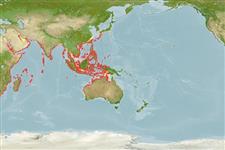Common names from other countries
>
Clupeiformes (Herrings) >
Engraulidae (Anchovies) > Engraulinae
Etymology: Encrasicholina: Greek, egkrasicholos, -os, -on = mixed with spleen.
More on author: Fowler.
Environment: milieu / climate zone / depth range / distribution range
Ekologi
marina revassocierade; havsvandrande (Ref. 51243); djupintervall 5 - 35 m (Ref. 86942). Tropical; 42°N - 35°S, 30°E - 140°E (Ref. 189)
Indo-Pacific: Red Sea and Persian Gulf south to perhaps Durban in South Africa, Pakistan, India, Sri Lanka, and probably Burma. Also from southern Japan to China, Philippines, Thailand, Indonesia south to Brisbane, Australia, Japan eastward to Hawaii, the Solomon Islands, Fiji, Samoa and Tahiti.
Length at first maturity / Size / Vikt / Age
Maturity: Lm ?, range 7 - ? cm
Max length : 13.0 cm TL hane/ej könsbestämd; (Ref. 189)
Taggstrålar i ryggfenan (totalt) : 0; Mjukstrålar i ryggfenan (totalt) : 12 - 15; Taggstrålar i analfenan: 0; Mjukstrålar i analfenan: 14 - 17. Belly rounded with 3 to 6 sharp needle-like pre-pelvic scutes. Maxilla tip blunt, scarcely projecting beyond second supra-maxilla, not reaching to front border of pre-operculum. Isthmus short, preceded by small fleshy plate on urohyal between branchial membranes. Anal fin short, its origin behind base of last dorsal fin ray.
Epipelagic (Ref. 58302). A schooling species found inshore and in oceanic waters, hundreds of miles from land. Sometimes entering large atoll lagoons or deep, clear bays. Ranks among the most important food (bait) for tuna and other large pelagic fishes (Ref. 1602). Processed into nuoc-mam, a kind of fish pickle, in Indo-China (Ref. 4929).
Spawn in school (Ref. 205).
Whitehead, P.J.P., G.J. Nelson and T. Wongratana, 1988. FAO Species Catalogue. Vol. 7. Clupeoid fishes of the world (Suborder Clupeoidei). An annotated and illustrated catalogue of the herrings, sardines, pilchards, sprats, shads, anchovies and wolf-herrings. FAO Fish. Synop. 125(7/2):305-579. Rome: FAO. (Ref. 189)
IUCN Red List Status (Ref. 130435)
CITES (Ref. 128078)
Not Evaluated
Threat to humans
Harmless
Human uses
Fiskeri: mindre kommeriell; bete: usually
Verktyg
Special reports
Download XML
Internet-källor
Estimates based on models
Preferred temperature (Ref.
115969): 24.7 - 29.2, mean 28.3 (based on 928 cells).
Phylogenetic diversity index (Ref.
82804): PD
50 = 0.5039 [Uniqueness, from 0.5 = low to 2.0 = high].
Bayesian length-weight: a=0.00479 (0.00307 - 0.00746), b=3.26 (3.13 - 3.39), in cm Total Length, based on LWR estimates for this species & (Sub)family-body (Ref.
93245).
Trofisk nivå (Ref.
69278): 3.4 ±0.45 se; based on food items.
Resiliens (Ref.
120179): Hög, lägsta populationsfördubblingstid mindre än 15 månader (K=1.1-2.0).
Fishing Vulnerability (Ref.
59153): Low vulnerability (12 of 100).
